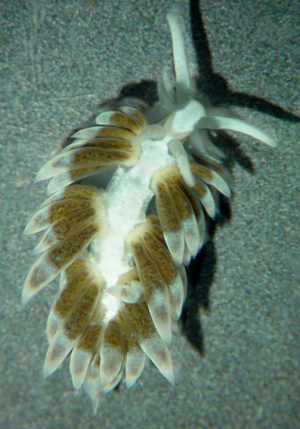
Aeolidiella stephanieae
Valdes, 2005
Order: NUDIBRANCHIA
Suborder: AEOLIDINA
Family: Aeolidiidae
DISTRIBUTION
Known only from the Florida Keys region, Florida, USA. but widespread in Nth American aquarium trade.
PHOTO
Florida Keys. It is a juvenile, about 1/2 - 3/4 inch long, but it looks essentially the same as an adult
The animal is translucent with most of the dorsal surface obscured by an opaque white patch which runs from the front of the head back between the oral tentacles before narrowing to pass beween the rhinophores before broadening again to fill the space between the ceratal clusters. From the photographs I have seen it seems that the white pigmentation also runs down each side of the body as well, but leaves a space around each ceratal cluster.
The foor appears translucent but there is a white line along the leading edge of the tentacular anterior foot corners. The basal third of the oral tentacles and rhinophores is translucent clear while the upper two-thirds is opaque white.The lower two-thirds of each ceras appears translucent clear with the brownish digestive gland showing through. The upper third of each ceras ihas some whirte pigmentation. The colour of the ceratal digestive gland depends on the state of the digestive cycle, as the colour results from the presence of zooxanthellae which are symbionts of the anemones that Aeolidiella feeds on.
The oral tentacles are smooth, while the rhinophores bear a few (5-6) obscure lamellae. The cerata are slightly flattened in shape and arranged in four clusters down each side. Withiin the clusters (or groups) the cerata are arranged in vertical rows.
This is the animal which Stephen Kempf has done so much work on, under the name Berghia verrucicornis [see message #6472]. It has been sold under that name in the aquarium trade as a way of cleaning Aiptasia infestations from aquaria. Steve Kempf suggests that the short-term retention of zooxanthella in the ceratal digestive gland illustrates a very early stage in the evolutionary process which led to solar-powered sea slugs.
-
Carroll, D.J. and S.C. Kempf. (1994). Changes occur in the central nervous system of the nudibranch Berghia verrucicornis (Mollusca, Opisthobranchia) during metamorphosis. Biological Bulletin, 186: 202-212.
-
Kempf, S.C. (1991). A "primitive" symbiosis between the aeolid nudibranch Berghia verrucicornis and a zooxanthella. Journal of Molluscan Studies, 57: 75-85.
-
Carroll, D.J. and S.C. Kempf. (1990). Laboratory culture of the aeolid nudibranch Berghia verrucicornis (Mollusca, Opisthobranchia): Some aspects of its development and life history. Biological Bulletin,. 179: 243-253.
-
Valdés, A. (2005) A new species of Aeolidiella Bergh, 1867 (Mollusca, Nudibranchia: Aeolidiidae) from the Florida Keys, USA. The Veliger, 47: 218-223.
Note: The animal used for Aiptasia control under the name Berghia verrucicornis is not that species. It is Aeolidiella stephanieae. See separate page for messages and discussion on 'Berghia verrucicornis' in aquaria [buying, selling, where to obtain, Aiptasia control etc].
Authorship detailsRudman, W.B., 2005 (August 20) Aeolidiella stephanieae Valdes, 2005. [In] Sea Slug Forum. Australian Museum, Sydney. Available from http://www.seaslugforum.net/factsheet/aeolstep
Related messages
-
Re: Berghia verrucicornis - aquarium culture [1]
From: Stephen C. Kempf, June 11, 2007 -
Re: 'Berghia verrucicornis' - Captive Life Span
From: Lisa Brown, March 29, 2006 -
New name for Aiptasia-feeding aeolid
From: Bill Rudman, August 20, 2005 -
Photo of 'Berghia verrucicornis' from Florida
From: Stephen C. Kempf , March 22, 2002
